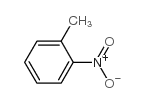2-Nitrotoluene

2-Nitrotoluene structure
|
Common Name | 2-Nitrotoluene | ||
|---|---|---|---|---|
| CAS Number | 88-72-2 | Molecular Weight | 137.13600 | |
| Density | 1.163 g/mL at 25 °C(lit.) | Boiling Point | 225 °C(lit.) | |
| Molecular Formula | C7H7NO2 | Melting Point | -9 °C | |
| MSDS | Chinese USA | Flash Point | 223 °F | |
| Symbol |



GHS07, GHS08, GHS09 |
Signal Word | Danger | |
|
Optimizations of packed sorbent and inlet temperature for large volume-direct aqueous injection-gas chromatography to determine high boiling volatile organic compounds in water.
J. Chromatogr. A. 1356 , 221-9, (2014) For the expanded application area, fast trace analysis of certain high boiling point (i.e., 150-250 °C) volatile organic compounds (HVOCs) in water, a large volume-direct aqueous injection-gas chromatography (LV-DAI-GC) method was optimized for the following ... |
|
|
Micellar electrokinetic chromatography of organic and peroxide-based explosives.
Anal. Chim. Acta 876 , 91-7, (2015) CE methods have been developed for the analysis of organic and peroxide-based explosives. These methods have been developed for deployment on portable, in-field instrumentation for rapid screening. Both classes of compounds are neutral and were separated usin... |
|
|
Reconstructing the evolutionary history of nitrotoluene detection in the transcriptional regulator NtdR.
Mol. Microbiol. 74(4) , 826-43, (2009) Many toxic man-made compounds have been introduced into the environment, and bacterial strains that are able to grow on them are ideal model systems for studying the evolution of metabolic pathways and regulatory systems. Acidovorax sp. strain JS42 is unique ... |
|
|
Oxidative release of nitrite from 2-nitrotoluene by a three-component enzyme system from Pseudomonas sp. strain JS42.
J. Bacteriol. 176(24) , 7462-7, (1994) Pseudomonas sp. strain JS42 utilizes 2-nitrotoluene (2NT) as the sole source of carbon and energy for growth. Intact cells catalyze the oxidation of 2NT to 3-methylcatechol and nitrite in a reaction that requires molecular oxygen. Cell extracts oxidized 2NT t... |
|
|
Major carcinogenic pathways identified by gene expression analysis of peritoneal mesotheliomas following chemical treatment in F344 rats.
Toxicol. Appl. Pharmacol. 214(2) , 144-51, (2006) This study was performed to characterize the gene expression profile and to identify the major carcinogenic pathways involved in rat peritoneal mesothelioma (RPM) formation following treatment of Fischer 344 rats with o-nitrotoluene (o-NT) or bromochloracetic... |
|
|
Evaluation of the dependence of aqueous solubility of nitro compounds on temperature and salinity: a COSMO-RS simulation.
Chemosphere 83(3) , 287-94, (2011) The solubility in pure and saline water at various temperatures was calculated for selected nitro compounds (nitrobenzene, 1,3,5-trinitrobenzene, 2-nitrotoluene, 3-nitrotoluene, 4-nitrotoluene, 2,4-dinitrotoluene, 2,6-dinitrotoluene, 2,3-dinitrotoluene, 3,4-d... |
|
|
2-Nitrotoluene, 3-nitrotoluene and 4-nitrotoluene.
IARC Monogr. Eval. Carcinog. Risks Hum. 65 , 409-35, (1996)
|
|
|
[Analysis of HPLC of isomers of nitrotoluene and nitrobenzoic acid].
Se Pu 17(4) , 397-8, (1999) Nitrotoluene and nitrobenzoic acid isomers were separated completely in less than 10 minutes by Kromasil C18 (200 mm x 4.6 mm i.d.), when V(CH3OH):V(H2O):V(THF) = 55:44:1 with beta-CD of 0.02 mol/L at flow rate of 2.0 mL/min (former 4 min) and 2.6 mL/min (lat... |
|
|
Carcinogenic potential of o-nitrotoluene and p-nitrotoluene.
Toxicology 183(1-3) , 221-34, (2003) The potential of o-nitrotoluene and p-nitrotoluene to cause cancer in mammalian species was studied in male and female F344/N rats and B6C3F1 mice. These chemicals are on the EPA list of high production chemicals and there is potential for human exposure (Hig... |
|
|
Unique patterns of gene expression changes in liver after treatment of mice for 2 weeks with different known carcinogens and non-carcinogens.
Carcinogenesis 26(3) , 689-99, (2005) Previously we demonstrated that the mouse liver tumor response to the non-genotoxic carcinogens oxazepam and Wyeth-14,643 involved more differences than similarities in changes in early gene expression. In this study we used quantitative real-time PCR and oli... |